Baasha
Limp Gawd
- Joined
- Feb 23, 2014
- Messages
- 251
Nice! So the release is imminent although it looks like Euro/Asia already has it(?). Anyway, definitely will be getting this and perhaps using the 49" Neo G9 as an accessory display! lel
Follow along with the video below to see how to install our site as a web app on your home screen.
Note: This feature may not be available in some browsers.
Its in stock at retailers at least in Sweden. Guessing in part due to the price being a bit hefty for most.Nice! So the release is imminent although it looks like Euro/Asia already has it(?). Anyway, definitely will be getting this and perhaps using the 49" Neo G9 as an accessory display! lel
Here in Finland it seems to be in pretty low quantity too. Two retail store chains that have it, one has messed up so that it can't even be ordered but reports "5+ in stock". The other store has already sold their whopping 4 monitors they had in store and reports 1-2 month delivery times.Its in stock at retailers at least in Sweden. Guessing in part due to the price being a bit hefty for most.
Tried the CRU variant when I had the QN900B with DSX but to no avail. Could be different for the G95NC though.Here in Finland it seems to be in pretty low quantity too. Two retail store chains that have it, one has messed up so that it can't even be ordered but reports "5+ in stock". The other store has already sold their whopping 4 monitors they had in store and reports 1-2 month delivery times.
Samsung's own website is still the best deal because you can buy with 0% interest payment for 12 months.
I'm hoping we will see some discounts in a few months for Black Friday. Hopefully the refresh rate issues etc are resolved by then.
In other news, I asked on Reddit if G95NC owners could try making custom resolutions like 5120x2160. As expected, the option is greyed out on Nvidia since the display uses DSC, but there may be another possibility for doing it via Custom Resolution Utility or registry hacking the Nv_Modes value which seemed to work on the previous G9 model even with DSC.
If those don't work out, the only way to use custom resolutions would be windowed mode and removing window styles from that so it acts like borderless window. This might come with an input lag penalty.
It really sucks that there is no 5120x2160 40" 120+ Hz ultrawide with similar capabilities as the Samsung.
Surely it wouldn't have been that hard to include 5120x2160 in the EDID?! Just baffling.Here in Finland it seems to be in pretty low quantity too. Two retail store chains that have it, one has messed up so that it can't even be ordered but reports "5+ in stock". The other store has already sold their whopping 4 monitors they had in store and reports 1-2 month delivery times.
Samsung's own website is still the best deal because you can buy with 0% interest payment for 12 months.
I'm hoping we will see some discounts in a few months for Black Friday. Hopefully the refresh rate issues etc are resolved by then.
In other news, I asked on Reddit if G95NC owners could try making custom resolutions like 5120x2160. As expected, the option is greyed out on Nvidia since the display uses DSC, but there may be another possibility for doing it via Custom Resolution Utility or registry hacking the Nv_Modes value which seemed to work on the previous G9 model even with DSC.
If those don't work out, the only way to use custom resolutions would be windowed mode and removing window styles from that so it acts like borderless window. This might come with an input lag penalty.
It really sucks that there is no 5120x2160 40" 120+ Hz ultrawide with similar capabilities as the Samsung.
Welcome to monitor developers and their insanity. I mean 3440x1440 has been requested for the previous models but has Samsung bothered to add it? Of course not.Surely it wouldn't have been that hard to include 5120x2160 in the EDID?! Just baffling.
Not sure if this monitor has built option to change screen ratios like the QN900B had, but that appeard as different monitors based on what selections you made in the gamebar (which is in itself expected). That also meant that you could have something like VRR activated for one of them but not the other and such.I've also recently discovered a quirk unique to Samsung. Their displays may switch to a completely different EDID depending on refresh rates and whether Adaptive Sync is enabled from the OSD. Why they do this, I don't know. Maybe some EDID size limitation or just because it was easier to manage in the display firmware.
As an example, if Adaptive Sync and 144 Hz is enabled I dump the EDID on my Samsung G70A 4K 144 Hz, I get a pretty barebones EDID that basically supports standard timings (crap resolutions for compatibility that nobody uses) and 4K 144 Hz. If I set the display to 120 Hz, I get a more full featured EDID that describes more stuff.
This sort of stuff may potentially be useful info if some EDID hacks are discovered in the future. I'd be interested to try if I can add a detailed timing for 5120x2160 that way for example.
Just wait for version 2 of this like the odyssey ark 2. /s
Hopefully the wrinkles get ironed out in this model though. Curious what TCL's version will be like also, especially since it's likely to have dolby vision support.
TCL... ewwww.
The total deal is worth $1.8 billion - 60% of the plant will be owned by CSOT, 10% by its parent company TCL, while the rest 30% will be handed out to the Suzhou government.
The plant produced 27% of Samsung Display’s total amount of LCD panels, with most of them being for monitors and TVs.
This step is a confirmation to earlier reports that Samsung is trying to discontinue its LCD business and will refocus to quantum dot screens.
The Korea Herald reported that the plant has three 8.5-generation production lines and one 11-generation line, the latter planning to begin manufacturing from early next year. Interestingly enough, the report also revealed Samsung Display reinvested $723 million into TCL-related companies to acquire 12.33% of their shares.
The only review so far I have seen measure overshoot was a South Korean one and those overshoot graphs seem to show the Extreme and Faster modes but even the review states people should use the Default mode which should have next to no overshoot issues.Why are people even considering this monitor? The overshoot at 240hz is just insanely bad.
Both the Odyssey G9 and Neo G9 lock you out of the overdrive settings when VRR is enabled and they all used the Faster mode preset. I expect this one will also be the same. If you look at the website of the Korean review, it states Faster is the default mode which makes sense as the Neo G9 and G9 use Faster when VRR is onThe only review so far I have seen measure overshoot was a South Korean one and those overshoot graphs seem to show the Extreme and Faster modes but even the review states people should use the Default mode which should have next to no overshoot issues.
This is pretty typical of most monitors Samsung releases - the default mode is fine and the Faster/Extreme modes are there to let them advertise some very fast response time but at a lot of overshoot. I wish they had more granularity in this regard.
Both the Odyssey G9 and Neo G9 lock you out of the overdrive settings when VRR is enabled and they all used the Faster mode preset. I expect this one will also be the same. If you look at the website of the Korean review, it states Faster is the default mode which makes sense as the Neo G9 and G9 use Faster when VRR is on
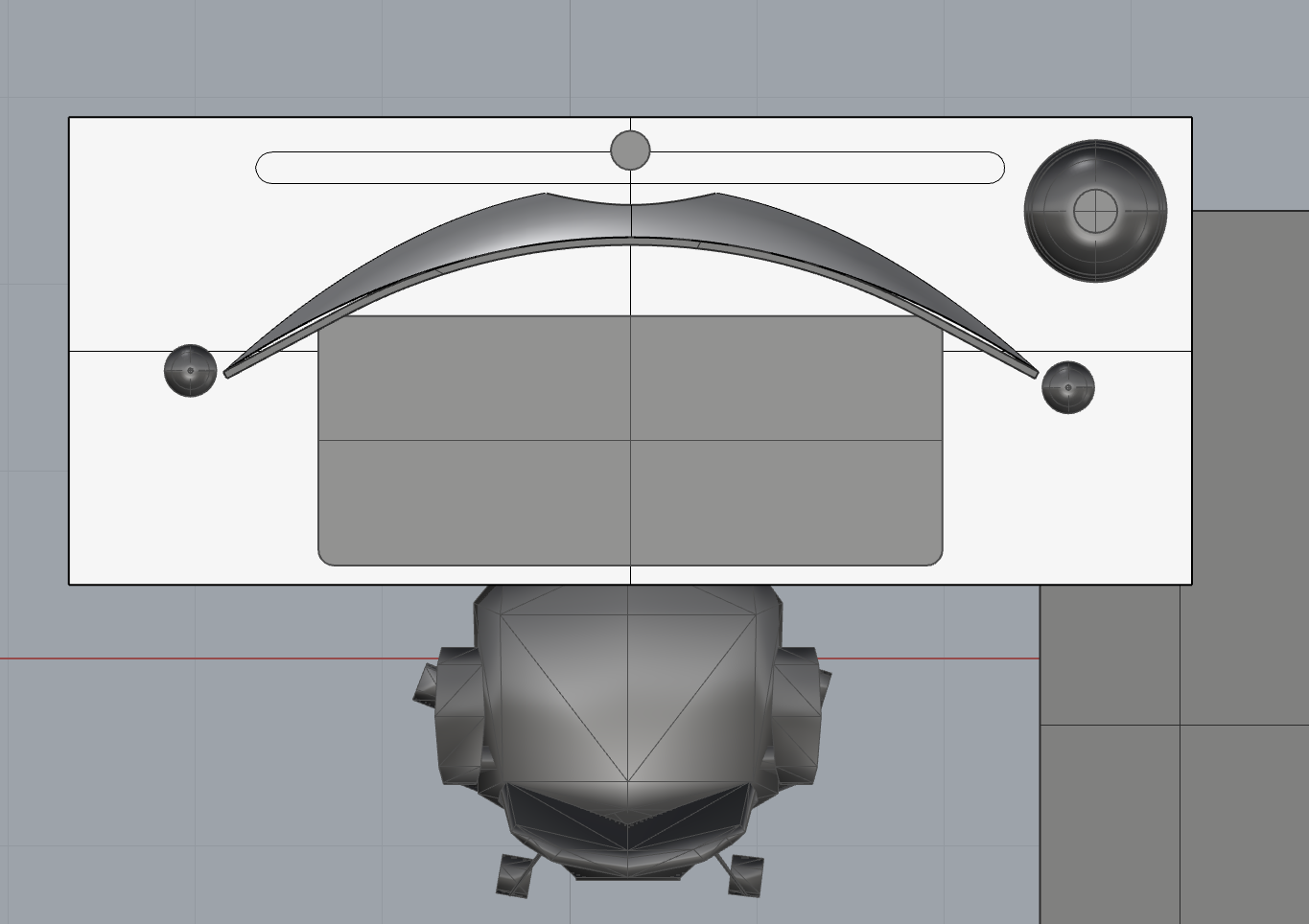

Yes, and we need to remember that those poor viewing angles is the real reason for the curve. I believe even Samsung themselves has stopped with the "Curved like the eye" nonsense now. Of course, some people might find the aggressive curve pleasing for various reasons, but for me it is mainly a tradeoff to combat poor viewing angles.Yeah I've never liked the way these encroach on your shoulders and completely dominate a desk making all the space under/behind useless. I wish it were curved far less aggressively but then we'd deal with really bad gamma loss due to the poor viewing angle of its VA panel.
Aesthetically it just looks bad on a desk.
I don't agree with that. I had the 1800R curve CRG9 and always wished it was more curved. I've tried the 49" Neo G9 and it felt nicer to use to me.Yes, and we need to remember that those poor viewing angles is the real reason for the curve. I believe even Samsung themselves has stopped with the "Curved like the eye" nonsense now. Of course, some people might find the aggressive curve pleasing for various reasons, but for me it is mainly a tradeoff to combat poor viewing angles.

I don't agree with that. I had the 1800R curve CRG9 and always wished it was more curved. I've tried the 49" Neo G9 and it felt nicer to use to me.
So to me it's a definite design feature rather than just to accommodate the VA panel.
It would be cool if they would make it adjustable curve like the LGs when Samsung eventually makes an OLED version of this.
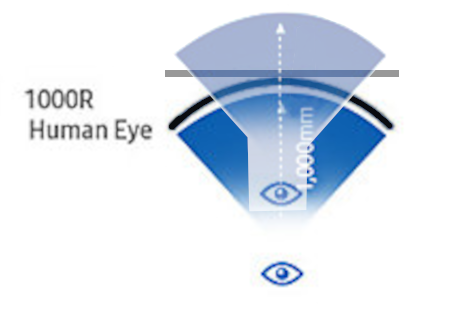

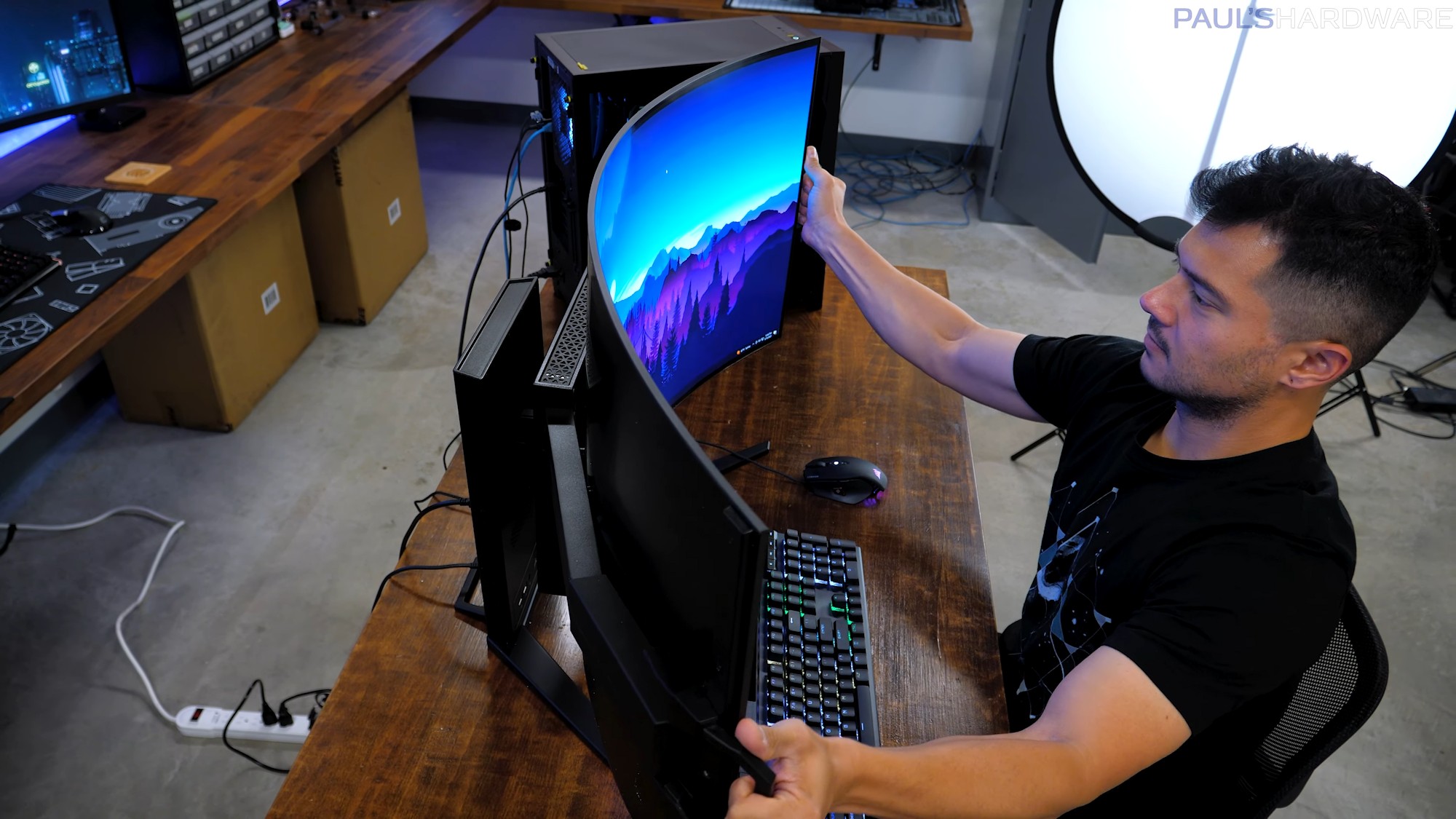
What did you get for your PG32UQX? I'm thinking of using this Samsung 57" Neo G9 (and my 49" Neo G9) on the UberRig while keeping the PG32UQX + Aorus FIU32 on the Z690 Rig. Need to get that Adtec stand tho...I sold my PG32UQX and am using a throw away 23" 60hz Dell monitor so unfortunately I don't have the patience to wait.
But yeah the biggest concerns so far are the QC (but that's a given with Samsung) + the refresh rate support and overshoot.
$1100. Hard to sell now days given the age and the fact that Amazon warehouse had tons of them for the same price.What did you get for your PG32UQX? I'm thinking of using this Samsung 57" Neo G9 (and my 49" Neo G9) on the UberRig while keeping the PG32UQX + Aorus FIU32 on the Z690 Rig. Need to get that Adtec stand tho...
Meanwhile the display is still $3775 at its cheapest here in Finland.$1100. Hard to sell now days given the age and the fact that Amazon warehouse had tons of them for the same price.
I'm not here to tell you if you should like the curve or not, but for many years, it seems like Samsungs desire to curve screens has been directly related to it's viewing angels. I would personally much rather have something flat providing that it had good viewing angles like OLED. One big reason for this is that the massive curve for productivity would mean you have to turn your head more to see the edges, unless you sit further away, in which case the curve itself starts to get a bit pointless. For gaming/immersion though, I can absolutely see a value in the curve and being surrounded by the image.I don't agree with that. I had the 1800R curve CRG9 and always wished it was more curved. I've tried the 49" Neo G9 and it felt nicer to use to me.
So to me it's a definite design feature rather than just to accommodate the VA panel.
It would be cool if they would make it adjustable curve like the LGs when Samsung eventually makes an OLED version of this.
Based on using the LG CX 48" as a monitor for a few years, my primary issue with it was the lack of a curve. Even with near perfect viewing angles it meant that the display needs to be a particular distance away to be comfortable to use because it does not curve towards you so looking at the corners becomes uncomfortable. I felt I had to move my head around too much compared to the Samsung CRG9 (1800R curve but similar width to the LG) I also had at the time. Due to the LG's height I mostly used it closer to a "tall ultrawide", utilizing the bottom 2/3rds of its screen in desktop use.I'm not here to tell you if you should like the curve or not, but for many years, it seems like Samsungs desire to curve screens has been directly related to it's viewing angels. I would personally much rather have something flat providing that it had good viewing angles like OLED. One big reason for this is that the massive curve for productivity would mean you have to turn your head more to see the edges, unless you sit further away, in which case the curve itself starts to get a bit pointless. For gaming/immersion though, I can absolutely see a value in the curve and being surrounded by the image.
I believe we need to separate the discussion of "a slight curve for a 16:9 or 21:9 monitor" from the "an aggressive curve for a 32:9 monitor". And also the reason why we like/dislike each. For me, an aggressive curve on a really wide monitor is not preferred as it would both basically take up my entire desk due to it's depth and also that it would force much more head turning to see the edges of the screen compared to a similar flat one.Unless you move further away of course, but then the idea of the aggressive curve is kind of lost. But what's right for me might not be for someone else and vice versa. I should add that I do perhaps 90% work and 10% gaming, so my needs are based on that. For something like a simracing, the G95NC would probably be the ideal monitor as well as the previous G9s.Based on using the LG CX 48" as a monitor for a few years, my primary issue with it was the lack of a curve. Even with near perfect viewing angles it meant that the display needs to be a particular distance away to be comfortable to use because it does not curve towards you so looking at the corners becomes uncomfortable. I felt I had to move my head around too much compared to the Samsung CRG9 (1800R curve but similar width to the LG) I also had at the time. Due to the LG's height I mostly used it closer to a "tall ultrawide", utilizing the bottom 2/3rds of its screen in desktop use.
So I'm totally onboard with devices like the Samsung ARK (though it could be much smaller) or the G95NC. The wider the display the more sense the curve makes.


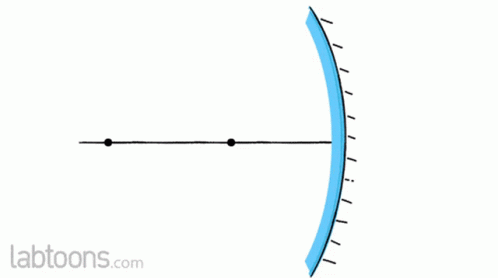

. . . . . . .https://www.scientificamerican.com/article/distorted-images/
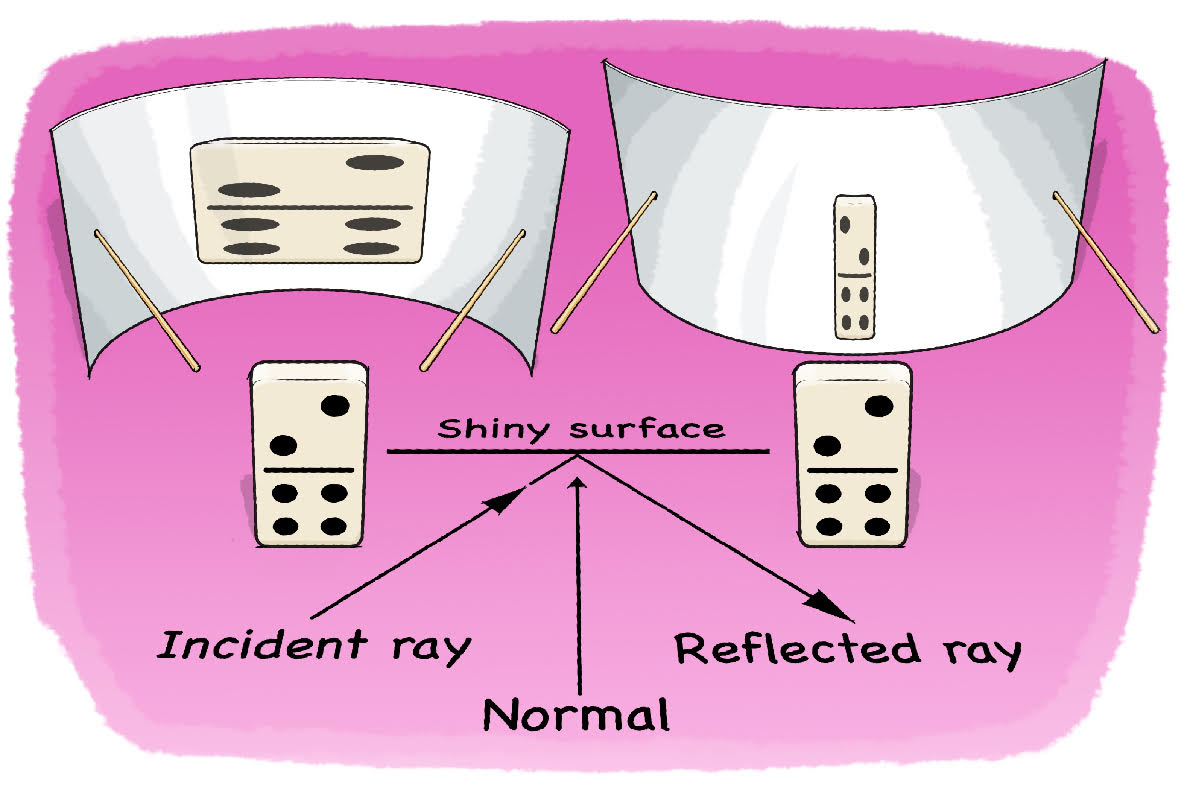
Light reflecting off of a surface is kind of like a ball bouncing on a floor. If the floor is flat and you drop the ball straight down, the ball will hit the floor and reverse direction, bouncing straight up. This direction is called "the normal" to the surface. If you drop the ball at an angle to this normal, it will bounce back at the other side of the normal, but with the same angle to the normal. The same principle applies to light reflecting (or bouncing back) from a surface. In this case, the ray of light approaching the surface is known as "the incident ray." If the incident ray strikes the reflective surface at a particular angle, the reflected ray leaves the surface at the same angle—but is located at the other side of the normal. In other words, the incident and reflected ray make a perfectly symmetrical V shape, with the normal as the line of symmetry.
" If the incident ray strikes the reflective surface at a particular angle, the reflected ray leaves the surface at the same angle—but is located at the other side of the normal. In other words, the incident and reflected ray make a perfectly symmetrical V shape, with the normal as the line of symmetry.". <----- Obviously, pixel lit displays aren't reflecting the image but they will have the vector of your line of sight vs the axis of the pixels on the screen. When the pixels are on axis, that angle is zero. When the pixels are off axis from sitting nearer than the center point of the curve, , that angle grows larger and larger the farther away from the center of the screen the pixels are.
When you are sitting far inside of the center point of a curved screen up close, light coming out of the screen farther from center is as if you bounced light or a tiny ball off of the screen and it reflected off at a tangent, off-axis and farther away from you the farther away from the center of the screen the pixels are. If you were sitting at the center of the circle (semi-circle segment that the screen is), any time you shot a rubber bead at the screen, theoretically in perfect conditions the surface would bounce it right back at you along the same vector in reverse (like in the animated gif above).
I think some games have warping of the game output to compensate but it's not standard by any means. Nvidia could probably come up with a tool for that if they wanted to as well but afaik there isn't any. A lot of people seem to change their FOV in an attempt to compensate for games that have FoV adjustment provided in the game settings or if you can force it with edits/mods - but you should be able to have other FoVs without warping if all of the angles vs.curvature were optimal. Imo it would be better if the screen design didn't have you sitting where the curve would warp(and also exacerbate uniformity issues)in the first place. You can tell that it's not just a game stretch/squash problem because the issue also presents itself on regular desktop stuff where for example the geometry (e.g. straight lines, circles, etc) are compromised.

Theoretically, they could design an uw or s-uw screen better so that you still get immersion on the sides when sitting at the center point of a curve. For example, the red line being a 120degree arc of a semicircle in the image below. The aggression of the curve and the centerpoint would have to appropriate in order to provide enough height to the screen though whatever the screen's actual height dimension might be.

For me it's probably 70-80% work, 20-30% gaming. I really enjoyed using the Samsung CRG9 49" 5120x1440 for work, but just want sharper text/UI because MacOS so heavily favors scaling for text rendering. So the G95NC is the next best thing.I believe we need to separate the discussion of "a slight curve for a 16:9 or 21:9 monitor" from the "an aggressive curve for a 32:9 monitor". And also the reason why we like/dislike each. For me, an aggressive curve on a really wide monitor is not preferred as it would both basically take up my entire desk due to it's depth and also that it would force much more head turning to see the edges of the screen compared to a similar flat one.Unless you move further away of course, but then the idea of the aggressive curve is kind of lost. But what's right for me might not be for someone else and vice versa. I should add that I do perhaps 90% work and 10% gaming, so my needs are based on that. For something like a simracing, the G95NC would probably be the ideal monitor as well as the previous G9s.